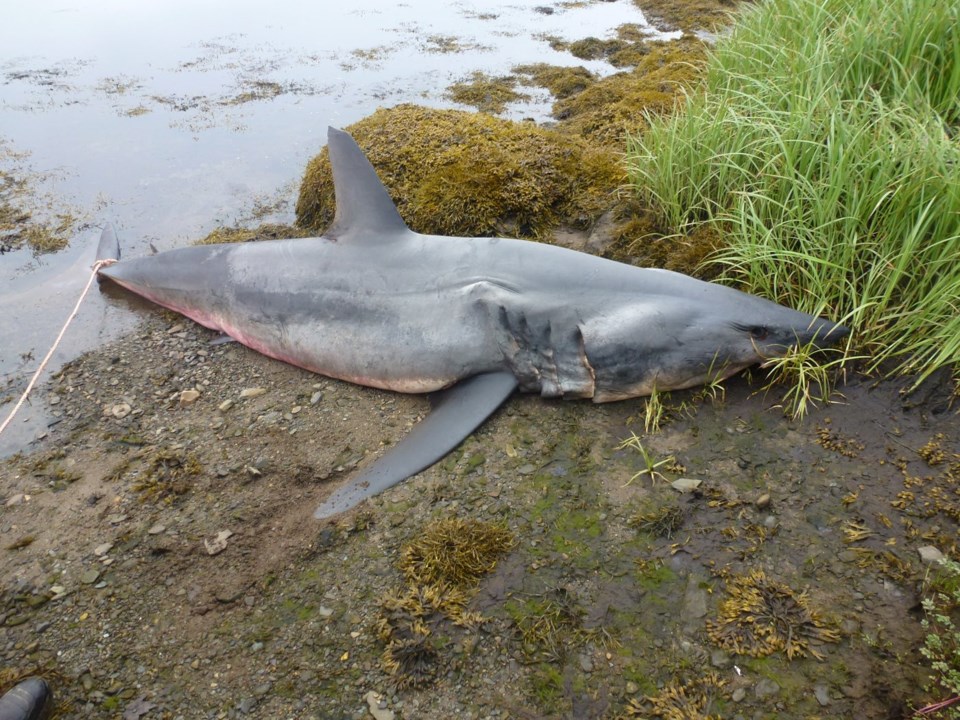PORT DUFFERIN — A marine animal rescue group has confirmed a rare but unfortunate find on Nova Scotia's eastern shore.
The Halifax-based Marine Animal Response Society says the remains of a large, shortfin mako shark — considered the fastest shark in the ocean — were found Saturday along the shoreline near Port Dufferin, N.S., about 140 kilometres east of Halifax.
Executive Director Tonya Wimmer said Monday it remains unclear how the adult, 3.6-metre female died.
"It wasn't in the greatest shape," Wimmer said in an interview, adding that the animal was too decomposed to allow for a necropsy. "She likely would have been there for a few days .... And there wasn't anything on the animal externally to give us any clues as to why it would be in this location."
It is unusual to find this type of shark near shore.
"They're usually offshore in warmer waters in the Gulf Stream, on the banks," Wimmer said. "It is a very rare thing for them to be this close to shore. But it has happened over the years."
According to the federal fisheries department, shortfin makos can grow to 3.9 metres in length, and they can swim at speeds reaching 68 kilometres per hour.
"It's an absolutely amazing animal," Wimmer said. "These are the fastest sharks that exist. They are phenomenal ... And they have these aerial displays at times when they'll jump out of the water."
Makos have been known to jump as high as six metres above the water.
As well, they frequent Browns Bank on the continental shelf off southwestern Nova Scotia, as well as the Gulf of St. Lawrence. They swim as far south as Argentina.
And they have a particularly intimidating look.
"The teeth are slender and slightly curved ... and are visible even when the mouth is closed, giving it a fearsome appearance," the fisheries department says on its website. As for their colouring, the department says they have white undersides and "metallic indigo blue" topsides.
They mainly eat squid, mackerel, tuna, bonitos and swordfish. But other sharks and porpoises are sometimes on the menu.
"It is rarely encountered by swimmers or divers due to its oceanic nature and should be treated with respect and caution," the department says. "The mako has been known to attack boats on occasion but most of these attacks are usually linked to being hooked by game fishers and are considered abnormal behaviour."
Little else is known about this elusive species, which was designated as endangered in 2019 by the independent Committee on the Status of Endangered Wildlife in Canada. The mako population is primarily threatened by longline fisheries that are trying to catch other fish.
In recent years, there has been an increase in shark sightings along Canada's East Coast, with reports of great white sharks getting most of the attention. Last July, the Ocean Tracking Network at Dalhousie University in Halifax confirmed it was working on a plan to to post warning signs for beachgoers for the first time.
Experts say conservation measures had helped the great white shark population recover from a drastic decline in the 1970s and 1980s. As well, they said climate change had led to warmer ocean temperatures, making it easier for many ocean species to spread northward.
But Wimmer said it's too early to tell what is happening with the makos.
"Climate change is affecting a lot of the marine animals in our ocean. We've seen it with whales, we've seen it with other species .... (But) we don't have a lot of information on makos. It is something still to be determined."
In 2002, several makos were caught during a shark fishing derby 16 kilometres from Halifax harbour. Two years later, a massive 1,085-pound mako was landed in Yarmouth, N.S., where it was hauled away with a forklift, its gaping jaws showing rows of hooked teeth.
Still, makos are seldom found in waters colder than 16 C, experts say.
This report by The Canadian Press was first published June 16, 2025.
— By Michael MacDonald in Halifax
The Canadian Press



